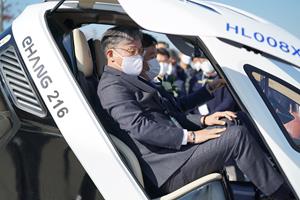 Drone taxis might soon be flying in cities around the world: report
Drone taxis might soon be flying in cities around the world: report
By Jim Magill
Drone taxis might soon be introduced in a city near you, according to a recent Markets and Markets report.
The global market for drone taxis is expected to grow from an estimated $74 million in 2025 to reach $860 million by 2030, a compound annual growth rate (CAGR) of 63%, according the study, Drone Taxi Market – Global Forecast to 2030.
The 44-page report studied the potential growth of the market for drone taxis used to carry passengers for intracity or intercity transportation. “Drone taxis are designed to fly remotely piloted or autonomously, avoid obstacles, and take-off, fly and land precisely every time. Drone taxi propulsion can be fully electric or hybrid electric,” the report states.
The North America market is forecasted to see the fastest growth rate during the five-year period covered by the study. The U.S., with a projected CAGR of 104.3%, is the leading country in this region. Researchers point to strategic partnerships between drone-taxi manufacturers and ride-sharing companies, as well as robust investment in the business segment as the drivers behind the growth in the North American drone-taxi market.
“For instance, in January 2020, Joby Aviation entered into a strategic partnership with Toyota and Uber,” the study says. “Air taxis are likely to witness heightened demand for urban transportation in this region.”
Although the North American market is projected to grow at the fastest rate over the five-year study forecast period, Europe, currently the leading region in the drone-taxi market, with a 46% share, is expected to continue to lead the market over that period.
The study cites some of the advantages of drone taxis, which include reduction in traffic congestion, sustainability, increased transportation efficiency and noise reduction.
Some of the prominent key players in the burgeoning market include: U.S.-based companies Boeing and Joby Aviation; German companies, Lilium and Volocopter; Netherlands-based Airbus and China-based Ehang.
Stakeholders in the market include drone-taxi manufacturers, system parts and subcomponent manufacturers, air-taxi operating companies, research organizations, forums, alliances and associations, original equipment manufacturers (OEMS), regulatory bodies and research and development companies.
The researchers attributed the expected market growth to recent technological developments in next-generation aviation vehicles as well as the transportation challenges faced by cities around the world due to the increasing road traffic. “Growth in disposable income, coupled with the reducing cost of automobiles for personal use, has led to an increase in the number of automobiles, thereby increasing environmental concerns,” the report states.
As a result of these environmental and congestion concerns, “cities are expected to adopt transportation systems using unmanned systems.”
Over the past several months, the global COVID-19 pandemic has had a dramatic impact on the growth of the drone-taxi market, impacting the industry’s supply chain and delaying the commercialization of the vehicles by about a year, researchers found.
“The spread of COVID-19 in the US and EU is expected to have a negative impact due to lockdowns at research & development facilities of drone-taxi vehicles,” the report says. “The lockdown in the Asia Pacific [region] has resulted in business losses for many upcoming startups in the urban air mobility industry, including drone taxis.”
As a result of the pandemic, a number of startup companies serving the drone-taxi industry were forced to cease operations due to delays in development and loss of capital.
Another major challenge facing the drone-taxi market is seen in the imposition of restrictions by the aviation regulatory agencies across the world, including the Federal Aviation Administration (FAA) in the U.S., the European Union Aviation Safety Agency, Australia’s Civil Aviation Safety Authority and India’s Directorate General of Civil Aviation.
These agencies are responsible for approving the commercial operation of electric vertical takeoff and landing (VTOL) vehicles in their respective countries. The researchers predicted that in the U.S., the FAA would begin to certify the operation of electric VTOLs including drone taxis, after witnessing a number of hours “of safe and predictable real-world experimental operations.”
Based on end use, researchers project that the scheduled-operator segment of the drone taxi market will grow at the fastest rate between 2025 and 2030. “This growth is attributed to congested cities and the need for faster transport with defined travel routes to enable reaching from one destination to another,” the study states.
However, the analysts predict that ride-sharing companies will account for the largest market share during the forecast period. They credit the large number of air-taxi operators and the expected increase in the adoption of ride-sharing taxis in the years following 2025.
Read more about Joby Aviation, aerial ride sharing, and drone taxis in Korea and in Japan.
 Jim Magill is a Houston-based writer with almost a quarter-century of experience covering technical and economic developments in the oil and gas industry. After retiring in December 2019 as a senior editor with S&P Global Platts, Jim began writing about emerging technologies, such as artificial intelligence, robots and drones, and the ways in which they’re contributing to our society. In addition to DroneLife, Jim is a contributor to Forbes.com and his work has appeared in the Houston Chronicle, U.S. News & World Report, and Unmanned Systems, a publication of the Association for Unmanned Vehicle Systems International.
Jim Magill is a Houston-based writer with almost a quarter-century of experience covering technical and economic developments in the oil and gas industry. After retiring in December 2019 as a senior editor with S&P Global Platts, Jim began writing about emerging technologies, such as artificial intelligence, robots and drones, and the ways in which they’re contributing to our society. In addition to DroneLife, Jim is a contributor to Forbes.com and his work has appeared in the Houston Chronicle, U.S. News & World Report, and Unmanned Systems, a publication of the Association for Unmanned Vehicle Systems International.
Miriam McNabb is the Editor-in-Chief of DRONELIFE and CEO of JobForDrones, a professional drone services marketplace, and a fascinated observer of the emerging drone industry and the regulatory environment for drones. Miriam has penned over 3,000 articles focused on the commercial drone space and is an international speaker and recognized figure in the industry. Miriam has a degree from the University of Chicago and over 20 years of experience in high tech sales and marketing for new technologies.
For drone industry consulting or writing, Email Miriam.
TWITTER:@spaldingbarker
Subscribe to DroneLife here.
https://dronelife.com/2022/01/13/drone-taxis-are-big-business-the-new-ride-share/
 Unmanned Aerial Vehicle The latest drone news
Unmanned Aerial Vehicle The latest drone news




